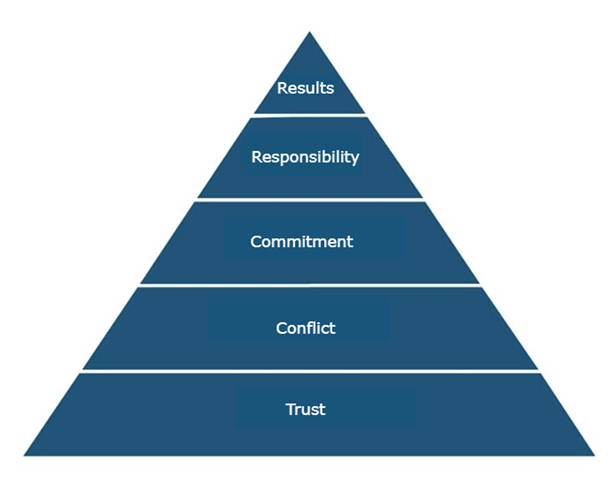The five dysfunctions of a team
Patrick Lencioni’s model, "The Five Dysfunctions of a Team," describes the most common challenges that teams may face and explains how these can be overcome to create effective and well-functioning collaboration. The model is structured as a pyramid with five levels, where each dysfunction builds on the previous one:

1. Absence of trust
Definition: The absence of trust is the foundational dysfunction and is about the unwillingness to be vulnerable with one another. In teams with low trust, members hide their mistakes and weaknesses, which creates distance and hinders collaboration.
Solution: To build trust, the team should focus on creating a culture where it is safe to show vulnerability. This can be achieved by:
- Participating in team exercises where members share personal experiences and challenges.
- Using personality profiles such as Everything DiSC®, which provide insights into individual differences and behavioral preferences.
- Emphasizing common goals and fostering a culture where mistakes are seen as opportunities for learning.
2. Fear of conflict
Definition: When trust is lacking, team members often avoid conflict for fear of confrontation and negative consequences. The result is superficial discussions and unresolved issues that undermine the decision-making process.
Solution: Healthy conflict can promote growth and innovation within the team. Leaders can facilitate open dialogue and ensure that conflicts are handled professionally by:
- Ensuring psychological safety so that the team feels secure expressing disagreements.
- Providing support in conflict resolution, for example through CfL’s course in conflict management and collaboration, which offers tools to address and resolve conflicts constructively.
- Establishing clear rules of engagement for handling conflicts, so that team members can navigate disagreements without fear of negative repercussions.
3. Lack of commitment
Definition: Without open conflict and discussion, team members may feel uncertain about decisions, leading to a lack of commitment. If not everyone is behind the team’s decisions, it becomes difficult to work towards a common goal.
Solution: To ensure commitment, leaders should encourage full participation in the decision-making process. Methods include:
- Setting clear goals and roles so that everyone understands their responsibilities and the team’s overarching objectives.
- Using structured decision-making tools, where the team can openly discuss different viewpoints.
- Establishing firm deadlines so that everyone knows when they need to support the team’s direction.
4. Avoidance of accountability
Definition: Without clear commitment, it is easy for team members to avoid accountability. They may hesitate to point out mistakes or underperformance, leading to inefficiency and a diminished sense of responsibility.
Solution: Accountability requires that team members adhere to the agreements made and that there is a mutual understanding of responsibilities. This can be promoted by:
- Implementing team-based metrics so the team has a common goal to work towards.
- Regular follow-ups where team members have the opportunity to give constructive feedback to each other.
- Aligning expectations to ensure everyone knows the team’s goals and standards.
5. Inattention to results
Definition: If the previous four dysfunctions are not addressed, focus often shifts to individual goals rather than the collective success of the team. The team risks becoming ineffective because it lacks a clear common direction and dedication to achieving results.
Solution: A clear focus on results is crucial for the team’s progress. Concentrate on collective outcomes by:
- Establishing clear team goals that all members understand and support.
- Making progress visible so the team can see how their efforts contribute to the whole.
- Rewarding team performance over individual performance to strengthen collective objectives and cohesion.
How CfL can help strengthen teams
CfL offers a range of tools and courses that can help overcome these dysfunctions. Our course programs – such as courses in psychological safety, conflict management, and the Everything DiSC® tool – are designed to create stronger teams by focusing on communication, trust, and effective conflict resolution.
You are always welcome to contact us for a tailored solution that meets your organization’s specific needs.





